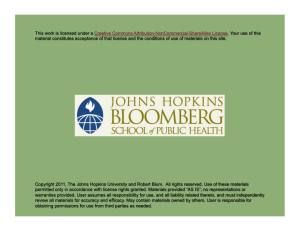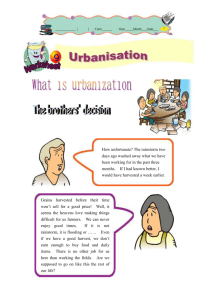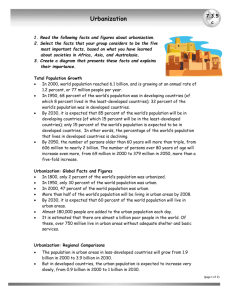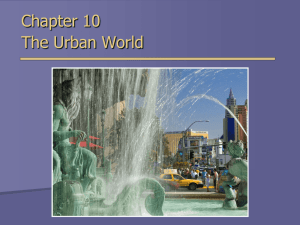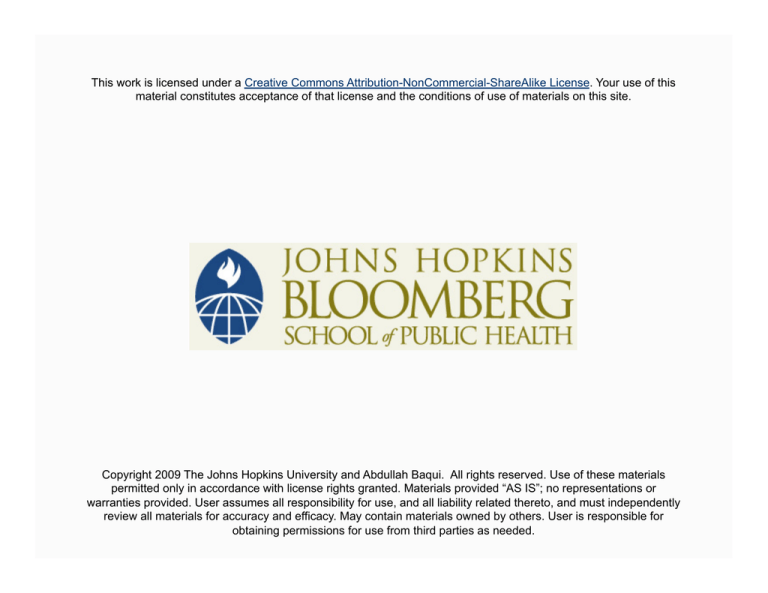
This work is licensed under a Creative Commons Attribution-NonCommercial-ShareAlike License. Your use of this
material constitutes acceptance of that license and the conditions of use of materials on this site.
Copyright 2009 The Johns Hopkins University and Abdullah Baqui. All rights reserved. Use of these materials
permitted only in accordance with license rights granted. Materials provided “AS IS”; no representations or
warranties provided. User assumes all responsibility for use, and all liability related thereto, and must independently
review all materials for accuracy and efficacy. May contain materials owned by others. User is responsible for
obtaining permissions for use from third parties as needed.
Global Urbanization: Trends, Patterns,
Determinants, and Impacts
Abdullah Baqui, DrPH, MPH, MBBS
Johns Hopkins University
Section A
Session Outline
Session Outline
Global trends of urban population growth
Patterns of urban population growth
4
Global Urbanization Trend
Only about 30% of the world’s population lived in urban areas in
1950
The proportion rose to ~50% by 2007
Projected urban share of global population in 2030 is ~60%
5
World’s Population Living in Urban Areas, 1950–2030
6
5
Population (billions)
5
4
3.3
3
1.54
2
1
0.75
0
1950
1975
2007
2030
Year
Urban population
6
Growth of Rural vs. Urban Population (in billions)
1950
1975
2007
2030
Rural
1.77
2.52
3.3
3.29
Urban
0.75
1.54
3.3
5
7
Growth of Rural vs. Urban Population
Between 2007 and 2030, the world’s population is expected to
increase by 1.8 billion
Almost all population growth during this period will be in urban
areas
The rural population will actually decrease by about 20 million
8
Urban Population: Developed vs. Developing Countries (in billions)
Process advanced in developed nations, where 76% lived in urban
areas in 2000, and will increase to 83% by 2030
Only 40% of those in developing countries lived in urban areas in
2000, increasing to 56% by 2030
1950
1975
2000
2030
Developed
55
70
76
83
Developing
18
27
40
56
9
Urban Growth: Developing and Developed Countries
Overall urban and rural population growth rates: developing and
developed countries
10
Urban vs. Rural Growth: Developing Countries
Population growth will be particularly rapid in the urban areas of
less developed countries, averaging 2.4% per year during 2000–2030
At this rate, developing country urban population will double in 29
years
In contrast, the rural population of the developing regions is
expected to increase very slowly, at just 0.02 per cent per year
during the same period
11
Urban vs. Rural Growth: Developed Countries
In developed countries, average annual rate of urban growth was
only 0.83% between 1975 and 2000
The rate is projected to fall to 0.41% during the first quarter of this
century
The rural population has been declining for decades—from 370
million in 1950 to an anticipated 215 million in 2025
12
Implications for Developing Countries
Although developing countries are less urbanized, the rate of
urbanization is much higher
The number of people added each year continues to rise because
the rates are applied to an ever increasing population base
The annual growth rate of 3.5% during 1975–2000 was applied to the
1975 urban population of 810 million
13
Implications for Developing Countries
The 2.4% annual growth rate will be applied to a larger urban
population base of 1.94 billion
The number of persons added to the urban population in developing
countries indicates the challenges faced by governments, urban
planners, non-government service providers, and urban residents
14
Population in Urban Areas, by Region
Percent of population living in urban areas, by major developing country regions
1950
1975
2000
2025
Sub-Saharan Africa
11%
21%
34%
49%
Asia (except Japan)
15%
22%
35%
50%
Latin American &
Caribbean
41%
61%
75%
82%
Source: United Nations. (2000). World urbanization prospects: The 1999 revision.
15
Variations by World Region
Despite their high levels of urbanization, the combined numbers of
urban population in Europe, Latin America, Caribbean, North
America, and Oceania (1.2 billion) is smaller than the number in
Asia alone (1.4 billion)
By 2030, Asia will account for 54% of the urban population of the
world
16
The Rise of “Mega-Cities”
One feature of today’s urbanization is the continuing growth of
large cities, including mega-cities
The number of mega-cities rose from just one in 1950 to 23 in 1995,
with 17 of them in the developing world
By 2015, the number is projected to grow to 36; 23 of these megacities will be located in Asia
17
Cities with More Than 5 Million: 1950, 2000, 2015
Source: United Nations. (2000). World urbanization prospects: The 1999 revision.
18
Cities with More Than 1 Million: 1975, 1995, and 2015
1975
1995
2015
Developed
85
114
138
Developing
110
250
426
19
Proportion Living in Large and Small Cities
Although the number of large cities is increasing, much of the urban
population lives in small cities
In 2000, 24.8% of the world’s population lived in urban settlements
with fewer than 500,000 inhabitants
By 2015 that proportion is likely to rise to 27.1%
20
Urban Growth: Large vs. Small Cities, 2000–2015
Large cities (>5 million)
20.9%
Small cities (<500,000)
44.4%
In both cases, cities in the less developed regions will absorb most
of the increase
21
Section B
Global Urbanization: Determinants, Issues, and Concerns
Session Outline
Determinants of urban population growth
Issues related to rapid urbanization
Impact of rapid urbanization
23
What Factors Contribute to Urban Population Growth?
Urban population grows as a result of
- Natural increase
- Internal rural-to-urban migration
- International urban migration
- Reclassification of urban boundaries to encompass formerly
rural areas
24
Relative Contributions of Factors in Urbanization
About 60% of the urban population growth in developing countries is
due to natural increase
The remaining 40% is attributable to net rural-urban migration and
reclassification of rural areas into urban sites
However, these relative contributions vary by the status of overall
socioeconomic development of a location
As fertility levels decline and economic development increases,
migration assumes a greater role in determining the pace of urban
growth
25
Relative Contributions of Factors in Urbanization
In Africa, for example, natural increase accounts for 75% of urban
growth, compared with about 51% in Asia
In China, which has experienced rapid economic growth, only 28% of
the urban growth results from natural increase
The demographic dynamics underlying urban growth are complex
Most analyses are based on census data, but census data often miss
important factors, such as circular migration, and less direct or
long-term effects of migration
26
What Is Circular Migration?
Throughout Southeast Asia and Sub-Saharan Africa, millions of
people move back and forth between urban and rural areas to take
advantage of income-earning opportunities—a phenomenon known
as circular migration
Temporary migrants can cause large swings in population size
In some cities of China, for instance, temporary migrants are
estimated to account for one-fifth to one-third of the total urban
population
27
Rural-Urban Migration
In many countries, such temporary migrants are counted as rural
residents
Official statistics thus tend to underestimate levels of urbanization
and migration’s actual contribution to urban growth
Rural-to-urban migration becomes a less important contributor of
urban growth once the national level of urbanization is relatively
high
28
Who Migrates and Why?
The two important factors that affect migration are “pull” and
“push” factors
Pull factors: opportunities in cities, including high urban wages paid
by transnational corporations
Push factors: poor conditions in the countryside, e.g., health,
fragmentation of farm land, limited job, educational, and economic
opportunities
29
Demographic Characteristics of Migrants
Rural-to-urban migration is a selective process
People with certain characteristics are more likely to move than
people with other characteristics
One of these factors is gender because employment opportunities
vary greatly by gender
Gender selectivity in migration distorts gender ratios in both
destinations and origins
30
Gender Selectivity in Migration
Gender selectivity of rural-urban migration may change
over time as …
- Urban job opportunities for women increase or
decrease relative to opportunities for men
- Family norms regarding the migration of women
change
31
Distorted Gender Ratio and Its Impact
Gender ratios differ between urban and rural areas in many parts of
the world
Distorted gender ratios have implications for public health
In sub-Saharan Africa, for example, there are many more men than
women in urban areas because more jobs are available for men
The excess of males in African cities is considered one of the driving
forces behind the HIV/AIDS epidemic
32
Distorted Gender Ratio and Its Impact
In Latin America, the Caribbean, and South Asia, urban populations
include more women than men
These women work in domestic and low-skilled export-oriented jobs
They often send money to their families in rural areas and thereby
contribute to the rural economy
However, they also tend to suffer from a high prevalence of
violence and sexual abuse
33
Demographic Characteristics of Urban Populations
In developing countries, there are fewer very young and very old
people in urban areas
It is less easy for them to move and find jobs
The prime working ages are also the prime child bearing ages
That means there is a large need for reproductive, family planning,
and education services in urban areas
34
Positive and Negative Impacts of Urbanization
The impact of urbanization is mixed
Urbanization is an essential element to stimulate economic
development in cities
Urbanization has stimulated innovations in science and technology
and in systems of law and government
35
Positive Impacts of Urbanization
Cities have facilitated the diffusion of information through
interaction among diverse cultures
The density of urban populations offers significant cost advantages
for governments in the delivery of essential goods and services and
for the private sector in the production and consumption of such
items
Cities have also played a crucial role in reducing fertility
36
Negative Impact of Rapid Urbanization
However, rapid population growth in urban areas creates negative
economic, social, and environmental consequences
The uncontrolled in-migration and rapid urban growth is increasing
urban poverty and inequality
Poverty is one of the most critical issues facing urban areas
37
Negative Impact of Rapid Urbanization
Rapid urbanization has given rise to slum and squatter populations
An estimated 30–50% of urban inhabitants in developing countries
live in impoverished slums and squatter settlements
These settlements lack
- Adequate housing
- Adequate water, sanitation, refuse collection
- Adequate health care facilities
38
Negative Impact of Rapid Urbanization
Urban poverty degrades both physical and social environments
The urban poor areas are characterized by
- Crowding
- Pollution
- Concentration of the poor in central cities
- Violence and crime
- Prostitution
- Drug abuse
-
Street children
39
Negative Impact of Rapid Urbanization
The poor physical environment in turn increases morbidity and
mortality in cities more than in surrounding rural areas
The poverty-burdened social environment causes social instability,
which affects both physical and mental health
This was the case in some U.S. cities in 1900
40
Urban Challenges of Less Developed Countries
At the current pace and scale of change, over 60 million people are
added to the urban population each year
This rate of growth often strains the capacity of local and national
governments to provide even the most basic services to urban
residents
41
Urban Challenges of Less Developed Countries
Managing rapid urban population growth will be one of the world’s
most important challenges in the next few decades
About 80% of the world’s population resides in less developed
countries
In these countries, one of the central issues will be how to cope
with an unprecedented increase in the number of people living in
urban areas
42

